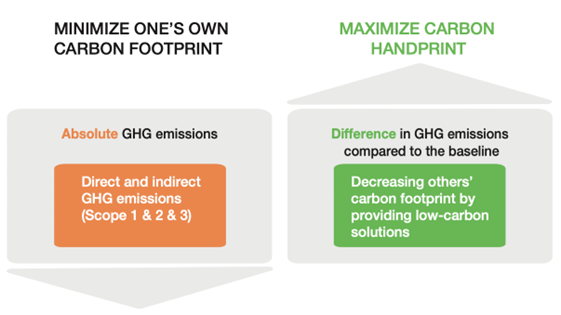As companies seek to disclose their greenhouse gas emissions, there is growing interest in improving the measurement of the climate impact from the use of goods and services that a company provides. This information, which has been labeled the carbon handprint, more accurately reflects a company’s contributions to the climate change problem and its solutions.
Researchers at MIT and at LUT University in Finland have developed methods for using the carbon handprint (also known as scope 4 emissions) as an approach to assess these emissions more accurately and consistently, and complement the more common carbon footprint, which is made up of the emissions resulting from the operations of the company. A new ACEEE white paper reviews the literature on estimating and reporting handprints and recommends that companies factor handprint into corporate environmental, social, and governance (ESG) policies.
The companies that take action to shrink their footprint while simultaneously growing their handprint will be those that are most effective at reducing emissions throughout their supply chains (see figure 1). Handprint estimates the environmental and climate impacts caused by a firm’s products and services over their life cycles, with a bigger handprint meaning more impact.
A company can create a positive handprint by delivering goods and services to help lower customers’ carbon footprint at its facilities or in the goods and services it sells. A new technology or emissions-reducing solution’s handprint can be estimated by comparing the business-as-usual practice against the new, reduced emissions scenario.

Figure 1. Carbon handprint versus footprint. Source: VTT 2021.
Intelligent Efficiency Is an Important Emissions Reducing Strategy
One key area for which the handprint approach is essential is for intelligent efficiency applications. Intelligent efficiency is a systems-based approach that gives implementers of technologies across the economy access to real-time information on energy use and savings and enables them to reduce energy waste by improving system-level operational efficiency and productivity. By using information and communication technologies (ICT), intelligent efficiency allows companies and their customers to develop unique and powerful ways to reduce greenhouse gas (GHG) emissions through responsiveness, optimization, and adaptability.
ACEEE research has shown that if homeowners and businesses take advantage of available ICT that promotes system efficiency, they could reduce energy use in the United States by about 12%–22%. In the commercial and manufacturing sectors, the annual energy cost savings from the use of ICT could exceed $50 billion. These effects could be multiplied even further through increased production and proliferation of ICT, and the research and development of other emerging technologies.
Over the past two decades, ICT has enabled the transition of energy efficiency from a static, device-focused improvement effort to one with a systems-optimization focus with bigger potential GHG reductions. Examples of energy savings measures that leverage the systems-wide impact of ICT include cloud computing and the Internet of Things. As more parts of the economy become interconnected and ICT technologies continue to improve, the pathways for reducing emissions through ICT will increase even further. For example, smart logistics and the ICT that enable them not only promote energy savings in isolated sectors like the food supply chain, oil and gas, and transportation but also foster interconnectedness across sectors, which allows for a more holistic, crosscutting approach to energy and GHG savings through comprehensive data collection, supply chain optimization and transparency, and waste reduction. As companies purchase energy-saving goods and implement more efficient services, the potential to reduce GHG emissions can be further expanded throughout the economy.
Accurate Attribution of Intelligent Efficiency Savings Is Enabled by the Handprint Approach
Estimating and attributing emissions reductions from ICT-enabled efficiency solutions is complicated because of the diverse and interconnected networks of companies that deliver these solutions. One promising approach to do so is by standardizing protocols to measure handprints.
To illustrate the application of handprint to ICT solutions, our new white paper considers two applications of ICT-enabled grid management solutions: one for electricity customers and the other for utilities to assess how ICT solutions may contribute to reducing GHG emissions and how credit for emissions reductions might be attributed among the ICT solution providers in these scenarios.
Our white paper identifies several approaches to including handprint in a GHG disclosure context for all entities that develop reporting standards. The two primary ones we describe are shared responsibility and shared credit and attribution of savings.
The shared responsibility and shared credit handprint approach appears promising in cases where handprint cannot be clearly identified and separated between value chain partners. In this approach, the companies in the value chain estimate the total impact and then negotiate on how best to share the credit to prevent double counting. Alternatively, the attribution of savings handprint approach is promising in cases where ICT enables the collection of detailed energy use and emissions data for components from different value chain partners.
ESG accounting approaches that embrace handprint measurement provide the opportunity to reflect both the responsibility for firms’ own contributions to GHG emissions—their footprint—and the impacts that their goods and services have on reducing customers’ emissions throughout the economy. Handprint reporting also offers a path for assigning responsibility for emissions while minimizing the potential for double counting of reductions.
Handprint offers a starting point for standardizing reporting of impacts of emissions reducing strategies like intelligent efficiency. Through ICT and intelligent efficiency, companies can better meet their often ambitious targets, as well as establish more aggressive emissions reduction targets to better reflect the economy-wide savings possibilities.






